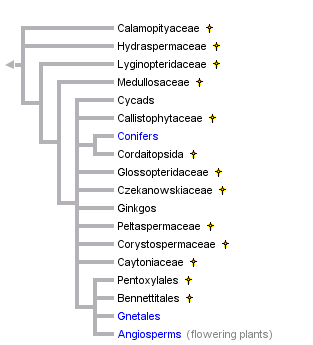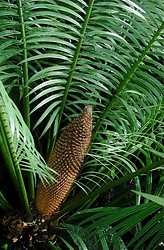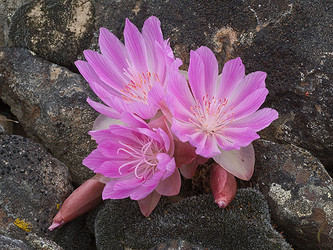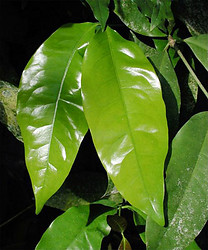Spermatopsida
Seed Plants
Peter Crane


This tree diagram shows the relationships between several groups of organisms.
The root of the current tree connects the organisms featured in this tree to their containing group and the rest of the Tree of Life. The basal branching point in the tree represents the ancestor of the other groups in the tree. This ancestor diversified over time into several descendent subgroups, which are represented as internal nodes and terminal taxa to the right.

You can click on the root to travel down the Tree of Life all the way to the root of all Life, and you can click on the names of descendent subgroups to travel up the Tree of Life all the way to individual species.
For more information on ToL tree formatting, please see Interpreting the Tree or Classification. To learn more about phylogenetic trees, please visit our Phylogenetic Biology pages.
close boxReferences
Bowe, L. M., G. Coat, and C. W. dePamphilis. 2000. Phylogeny of seed plants based on all three genomic compartments: Extant gymnosperms are monophyletic and Gnetales' closest relatives are conifers. Proceedings of the National Academy of Sciences (USA) 97:4092-4097.
Chaw S.-M., C. L. Parkinson, Y. Cheng, T. M. Vincent, and J. D. Palmer. 2000. Seed plant phylogeny inferred from all three plant genomes: monophyly of extant gymnosperms and origin of Gnetales from conifers. Proceedings of the National Academy of Sciences (USA) 97:4086-4086.
Donoghue, M. J. 1994. Progress and prospects in reconstructing plant phylogeny. Annals of the Missouri Botanical Garden 81:405-418.
Donoghue, M. J. and J. A. Doyle. 2000. Seed plant phylogeny: Demise of the anthophyte hypothesis? Current Biology 10:R106-R109.
Doyle, J. A. 1996. Seed plant phylogeny and the relationships of Gnetales. International Journal of Plant Sciences 157:S3-S39.
Doyle, J. A. 1998. Molecules, morphology, fossils, and the relationship of angiosperms and Gnetales. Molecular Phylogenetics and Evolution 9:448-462.
Chaw, S. M., C. L. Parkinson, Y. C. Cheng, T. M. Vincent, and J. D. Palmer. 2000. Seed plant phylogeny inferred from all three plant genomes: Monophyly of extant gymnosperms and origin of Gnetales from conifers. Proceedings of the National Academy of Sciences (USA) 97:4086-4091.
Judd, W. S., C. S. Campbell, E. A. Kellogg, P. F. Stevens, and M. J. Donoghue. 2002. Plant Systematics: A Phylogenetic Approach. Second Edition. Sinauer Associates, Inc., Sunderland, MA.
Rydin, C., M. Källersjö, and E. M. Friist. 2002. Seed plant relationships and the systematic position of Gnetales based on nuclear and chloroplast DNA: Conflicting data, rooting problems, and the monophyly of conifers. International Journal of Plant Sciences 163:197-214.
Sanderson, M. J., M. F. Wojciechowski, J. M. Hu, T. S. Khan, and S. G. Brady. 2000. Error, bias, and long-branch attraction in data for two chloroplast photosystem genes in seed plants. Molecular Biology and Evolution 17:782-797.
Schmidt, M. and H. A. W. Schneider-Poetsch. 2002. The evolution of gymnosperms redrawn by phytochrome genes: The Gnetatae appear at the base of the gymnosperms. Journal of Molecular Evolution 54:715-724.
Soltis, D. S., P. S. Soltis, and M. J. Zanis. 2002. Phylogeny of seed plants based on evidence from eight genes. American Journal of Botany 89:1670-1681.
Winter K.-U., A. Becker, T. Munster, J. T. Kim, H. Saedler, and G. Thiessen. 1999. The MADS-box genes reveal that gnetophytes are more closely related to conifers than to flowering plants. Proceedings of the National Academy of Sciences (USA) 96:7342-7347.
Information on the Internet
- International Plant Names Index (IPNI)
- World Checklist and Bibliography Series. An inventory of taxonomically validated seed plant names and associated bibliographic details, together with an annotated selection of relevant literature for individual genera as well as the family as a whole (under construction). Royal Botanic Gardens, Kew.
- Dendrome. A forest tree genome database.
- Gymnosperm Database
- The cycad pages
- The Ginkgo biloba pages
Title Illustrations

| Scientific Name | Cycas circinalis |
|---|---|
| Location | Cultivated at the Botanical Garden, Basel, Switzerland |
| Acknowledgements | courtesy Botanical Image Database |
| Specimen Condition | Live Specimen |
| Sex | Male |
| Body Part | flower |
| Copyright |
© University of Basel, Basel, Switzerland

|
| Scientific Name | Lewisia rediviva |
|---|---|
| Specimen Condition | Live Specimen |
| Source | Lewisia rediviva |
| Source Collection | Flickr |
| Image Use |
 This media file is licensed under the Creative Commons Attribution-NonCommercial-NoDerivs License - Version 2.0. This media file is licensed under the Creative Commons Attribution-NonCommercial-NoDerivs License - Version 2.0.
|
| Copyright | © 2007 wanderflechten |
| Scientific Name | Gnetum gnemon |
|---|---|
| Location | cultivated at the Botanical Garden Basel, Switzerland |
| Acknowledgements | courtesy Botanical Image Database |
| Specimen Condition | Live Specimen |
| Body Part | new and old leaves |
| Copyright |
© University of Basel, Basel, Switzerland

|
About This Page
Page copyright © 1996
All Rights Reserved.
Citing this page:
Crane, Peter. 1996. Spermatopsida. Seed Plants. Version 01 January 1996 (temporary). http://tolweb.org/Spermatopsida/20622/1996.01.01 in The Tree of Life Web Project, http://tolweb.org/












 Go to quick links
Go to quick search
Go to navigation for this section of the ToL site
Go to detailed links for the ToL site
Go to quick links
Go to quick search
Go to navigation for this section of the ToL site
Go to detailed links for the ToL site